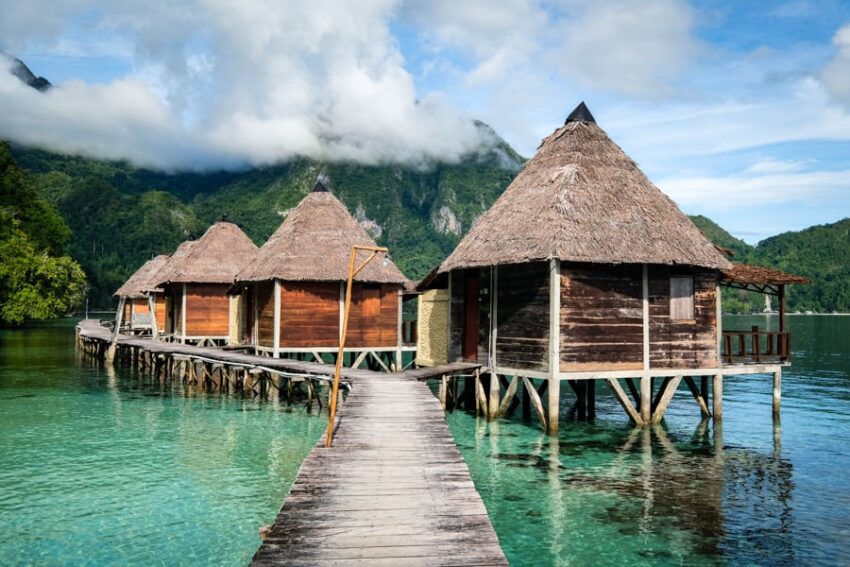Exploring the untouched wilderness of Seram Island offers an adventure unlike any other in Indonesia. Known for its dramatic landscapes, dense rainforests, and pristine coastlines, this destination remains relatively undiscovered compared to other parts of Maluku. Remote nature tourism on Seram Island is not only about breathtaking scenery, but also about immersing yourself in the unique way of life of the local communities. Travelers who embark on this journey will experience both challenging routes and rewarding cultural insights, making the island a true hidden gem.
Routes to Seram Island
Reaching Seram Island requires determination, as it is not as easily accessible as other tourist hotspots in Indonesia. Most visitors start their journey from Ambon, the capital of Maluku Province. From Pattimura International Airport in Ambon, travelers need to continue their trip to Tulehu Harbor. Regular ferries and speedboats connect Tulehu with Amahai, the main harbor on Seram Island. The trip by sea usually takes around two hours, depending on the weather.
Upon arrival in Amahai, travelers can choose to continue by road using public transport such as angkot (minibuses) or hire a private car. Roads on Seram vary in quality, with some routes paved and others more rugged, particularly when leading into the interior or remote coastal areas. It is advisable to plan ahead and, if possible, coordinate with local guides for the safest travel routes.
Read Also: Fedi Nuril Dihujat, Kontroversi Komentar Politik Trending X
Transportation within the Island
Transportation options within Seram Island reflect the island’s remote character. While major roads connect larger towns such as Masohi, Wahai, and Piru, venturing further inland often requires patience and flexibility. In smaller villages, transportation might be limited to motorcycles or small pickup trucks that double as shared taxis. Travelers should prepare for longer travel times and occasional breakdowns, as vehicles face tough conditions on bumpy and muddy roads.
For those seeking true adventure, trekking is one of the best ways to reach remote nature spots. Routes leading into Manusela National Park, for example, are often accessible only on foot. Hiring a local guide not only ensures safety but also provides valuable knowledge about the environment and culture. River crossings, suspension bridges, and dense rainforest trails are all part of the journey, creating a sense of exploration that makes every step worth it.
Read Also: Sarah Wijayanto dan Adinia Wirasti Ternyata Saudara Kandung
Experiencing Local Life
One of the highlights of remote nature tourism on Seram Island is the opportunity to engage with the local communities. The island is home to diverse ethnic groups, each with its own traditions, languages, and cultural practices. Villages scattered along the coast and in the highlands welcome visitors who are respectful and eager to learn.
Hospitality is a hallmark of Seram’s people. Travelers who stay in homestays or guesthouses run by local families can experience daily life, including traditional meals, storytelling, and music. Local dishes, often based on sago and fresh seafood, highlight the deep connection between the people and their environment. Festivals and ceremonies provide further insight into spiritual and communal life, showcasing dances, songs, and rituals that have been preserved for generations.
By participating in these cultural exchanges, travelers not only enrich their journey but also support sustainable tourism. Local communities benefit from visitors who appreciate and respect their heritage, creating a positive cycle of preservation and livelihood.
Read Also: Fakta Mengejutkan Sophia Latjuba Ternyata Sewa Rumah Mewah
Natural Attractions to Explore
Seram Island is renowned for its ecological richness. Manusela National Park, spanning over 1,800 square kilometers, is a haven for biodiversity. Endangered species such as the Moluccan cockatoo and the Seram bandicoot can be found here. Hiking through the park leads to stunning views, waterfalls, and challenging peaks like Mount Binaiya, the highest mountain in Maluku.
Coastal areas are equally captivating. White sandy beaches and clear waters surround the island, offering opportunities for snorkeling and diving. Coral reefs remain relatively untouched, making them ideal for those seeking underwater adventures without the crowds. Remote bays and lagoons provide serene spots for relaxation, while mangrove forests support diverse marine life.
For travelers who love caves, Seram also features fascinating limestone formations and underground rivers. These natural wonders enhance the sense of discovery that defines the island, offering both challenge and reward for explorers.
Sustainable Tourism and Conservation
Remote nature tourism on Seram Island goes hand in hand with environmental responsibility. The delicate balance of the ecosystem requires travelers to minimize their impact by following sustainable practices. Bringing reusable bottles, avoiding plastic waste, and respecting wildlife are simple yet crucial steps.
Local initiatives are increasingly focused on conservation. Community-based tourism projects ensure that income from visitors contributes to protecting forests, rivers, and coastlines. By supporting these programs, travelers not only enjoy the beauty of Seram but also help preserve it for future generations.
Travelers should also be mindful of cultural respect. Learning basic greetings in the local language, dressing modestly in villages, and observing community customs strengthen the relationship between visitors and hosts. In this way, tourism becomes not just an economic activity, but also a bridge of understanding.
Conclusion
Remote nature tourism on Seram Island is a journey for those who value adventure, culture, and authenticity. The challenging routes and limited transportation options are outweighed by the reward of experiencing pristine landscapes and genuine hospitality. By immersing in local life and respecting the island’s traditions and environment, travelers can create unforgettable memories while contributing to sustainable tourism. Seram remains one of Indonesia’s hidden treasures, waiting to be discovered by those willing to step off the beaten path.
